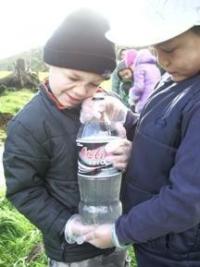Adopt a stream
When we rang the ACC to find out why the waterways are polluted, they told us to ring Metrowater who said to contact Watercare Services. A woman called Sally Smith who works for the Adopt A Stream programme offered to teach us about water pollution and how to test the streams to find out if they are clean.
So one clear July morning we returned to where Waiateao flows out from the zoo. First we did an observation of the waterway and saw plastic, glass, paper, concrete and a dead goose along the banks. We put gloves on so our hands didn't get germs.
Then we did a test to find out how turbid or muddy the water is as this helps to tell if the stream is healthy or polluted. Sally told us that animals can die in muddy water because they cannot see and find it hard to find their food. Their gills can also get blocked making it hard for them to breathe. Not all the numbers on the turbidity test disc were visible so we knew pollution was present in the stream.
After that we took the temperature of the water in the stream as the colder the water the more dissolved oxygen it has, which is important for the creatures living in it. The thermometer read 14 degrees Celsius which was a good sign. The next test was the water life observation. The adults carefully collected water from amongst the plants growing on the stream bank as well as digging up the mud. We used a bug dial to identify the insects or their larvae which we found. Different invertebrates are more or less sensitive to pollution. We found none of the bugs like mayflies and stoneflies who can not survive in polluted water, but did find some freshwater shrimps.
There were many of the bugs which can tolerate pollution: water snails, round and blood worms, midge and mosquito lava. So we decided that there must be quite a bit of pollution in Waiateao. The next question was where was it coming from.
Sally Smith pointed out the stormwater drains which flow into the stream and we talked about the chemicals and poisons which could enter Waiateao.
Later that day our teacher also showed us an article from the NZ Herald in which the Green Party said the Zoo was responsible for polluting Motion's Creek by washing the effluent from the hippo enclosures into it. The Zoo had responded by saying they treated the water first but were also installing a new system to filter the Hippo River flow twice before returning it to the stream. We thought we should write to them to see if they had installed it.










